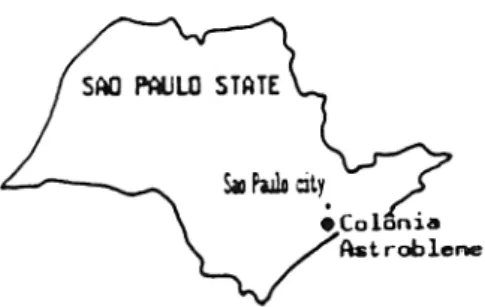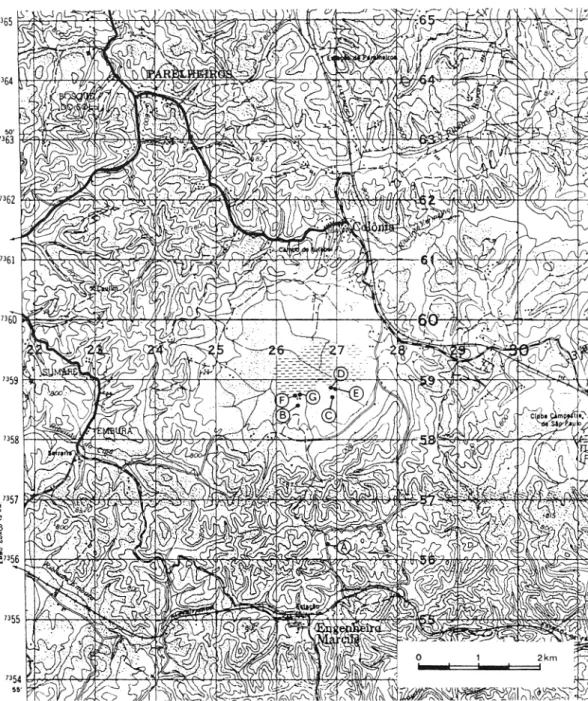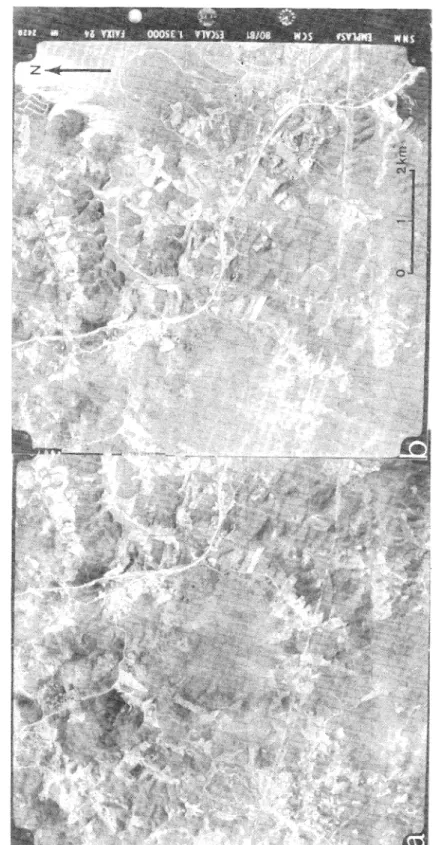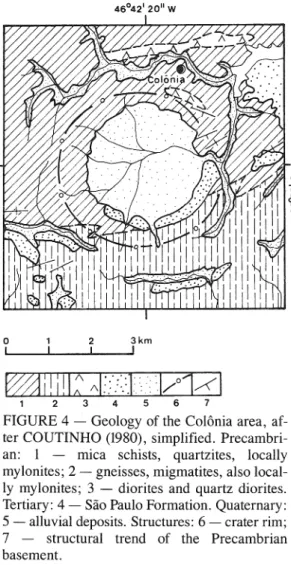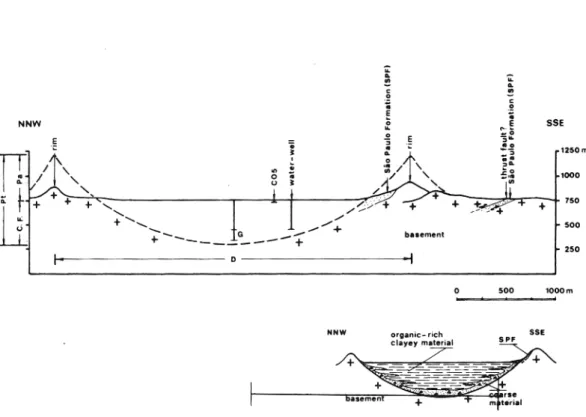Rev. IG, São Paulo, 12(1/2), 87-94, jan./dez./1991
THE COLÔNIA ASTROBLEME,
BRASIL
Claudio RICCOMINI Bruno TURCQ Louis MAR TIN Marcelo Z. MOREIRA Maria L. LORSCHEITTER
RESUMO
A estrutura de Colônia está localizada a cerca de 35km ao sul do centro da cidade de São Paulo. Ela apresenta formato circular, com 3,64km de diâmetro, estando preenchida por pelo menos 263m de sedimentos, correspondendo a uma provável estrutura de impacto, ou astroblema.
Essa feição é delineada por um anel externo circular, de relevo colinoso, desnivelado de até 125m em relação a uma planície aluvial interna pantanosa.
Este artigo apresenta um esboço da geologia regional da área e discute as diferentes hipó-teses concernentes à origem da estrutura, bem como os parâmetros morfológicos pertinentes à compreensão desta feição extremamente particular.
São apresentados também os resultados preliminares do estudo das amostras obtidas por vibrotestemunhador.
ABSTRACT
About 35km south of the city of São Paulo, near Colônia, within Precambrian crystal-line basement rocks, there is a well-defined ring feature, with 3.64km in diameter and filled by at least 263m of sediments, which corresponds to a probable astrobleme.
It is defined by a hilly circular outer rim up to 125m higher than an inner alluvial plain presently occupied by a large swamp.
This paper explains the regional geology of the area and discusses the different hypothe-sis as to the origin of the structure as well as the morphological parameters pertinent to an understanding of this feature.
Preliminary vibrocore data are also presented. 1 INTRODUCTION
Fewer than 150 impact structures of celes-tial orinterplanetary bodies at the Earth's sur-face, the so-calIed astroblemes, are recognized over our planet (GRIEVE
&
ROBERTSON, 1979, 1987). The study of astroblemes has re-cently increased because impact cratering was a fundamental process in the evolution of alI the terrestrial planets (SHOEMAKER, 1977), hence its importance in comparative planetology.About 35km from São Paulo, near Colônia (fig.l), there is a conspicuous ring feature, 3.64
km in diameter, centered at 23 052' S,
46°42'20"W, within Precambrian crystalIine basement rocks, and defined by a hilIy circular outer rim up to 125 m (figs. 2 and 3) higher than an inner alIuvial plain presently occupied by a large swamp, where the present-day water leveI may be, in part, controlIed by the Billings reser-voir just to the east.
The structure is locatedin the border of the Serra do Mar, a coastal mountain chain originalIy covered by the "Mata Atlântica" tropical rain forest with localized occurrences of Araucaria angustifolia (Bertol). Kuntze.
The hypothesis that this feature is a prob-able impact structure has long been postulated, ever since the first studies carried out in the area (KOLLERT
et ai.,
1961).In this paper the regional geology is briefly explained, different hypothesis as to the origin of the structure are discussed, and morphol-ogical parameters pertinent to an understanding of this feature are given. Preliminary vibrocore data are also presented.
2 REGIONAL GEOLOGICAL SETTING
The Colônia structure is located within the domain of the Ribeira Fold Belt (HASUI et ai. ,
Rev. IG, São Paulo, U(I/2), 87-94, jan./dez./199l
FIGURE 1 - Location of the Colônia Astrobleme. 1975). According to SADOWSKI (1974) and COUTINHO (1980) the main rock types of the region are gneisses, migmatites, diorites, mica schists, quartzites, mylonites, amphibolites, metabasites, granites and granodiorites (fig. 4). . The general structural trend of the basement
rocks is ENE.
Sedimentary rocks are exposed along the southern and southeastern borders of the struc-ture and are probably related to the Middle Eo-cene/Early Oligocene (MELO
et ai.,
1986) ar more precisely Oligocene (RICCOMINI et ai. , 1987) deposition of the São Paulo Formation, prominent in the São Paulo Basin located just to the north.All the rock types have been very intensely weathered, which makes geological observations difficult. Colluvial and alluvial deposits of prob-able Quaternary age are also present in the reglOn.
3 THE COLÔNIA STRUCTURE:
HYPOTHESIS AS TO ITS ORIGIN
. As mentioned above, ever since the first studies of this structure, the hypothesis of a
prob-able impact structure has been popular
(KOLLERT et ai. 1961). Further studies, main-ly those by CROSTA (1982, 1986), based on mor-phological parameters, have reinforced this idea. The presence of higher altitudes in the
south-western part of the rim has led
COUTI-NHO (1987, oral communication) to suppose a body trajectory from northeast before the shock.
Alternative hypothesis, such as (1) sinkhole, (2) structural interference pattern, (:3) intrusion and (4) crypto-explosion (phreato-magmatic structure related to a kimberlite), among others, may be rejected, respectively, by (1) the absence of carbonate rocks in the region, (2) the persis-tence of the ENE structural trend of the base-ment, (3 and 4) lhe lackof structures and/or
minor intrusive bodies (dikes, sills, etc.) that should be associated with such intrusions, and the excessively unusually large dimension for a kimberlite pipe. The hypothesis of a massive landslide structure as proposed by ERISMANN
et ai.,
(1977) for the Kõfels structure, near Inns-bruck (Tirol, Austria), previously believed to be an impact crater (e.g. SUESS, 1937; STORZERet ai.,
1971), is probably not applicable toColô-nia, mainly because of fundamental differences in the geometry of the two structures, Colônia being circular and Kõfels, irregular, roughly el-liptical, a shape not common among known as-troblemes.
Despite the above argument, no direct evi-dence of an impact, such as shock metamor-phism, has yet been observed in the area, most likely due to the intense weathering. The peculiar circular shape and the typical depth/diameter ra-tio (CROSTA, 1982, 1986), as well as the semi-circular outcrop pattern of the sedimentary rocks of the São Paulo Formation along the southern and southeastern inner part of the rim, are the main indicators of an astrobleme. The lack of convincing proof of endogeneous process also reinforces this hypothesis.
An interesting outcrop was referred to by COUTINHO (1979, oral communication) dose to the Colônia structure. Field observations for the present study revealed a probable thrust zone, striking WNW and dipping NNE. This outcrop is relativelywell exposed one kilometer south-ward from the structure, along the secondary road to Engenheiro Marsillac (site A, figo 2). Sandy to pebbly mudstones, probably of the São Paulo Formation, are tectonically imbricated within Precambrian gneisses of the basement. An ENE subverti cal family of joints is well developed in these sediments, leading to the assumption of an ENE compression axis (0"1) and a NNW
exten-sion axis (0"3)' This situation could represent a
Rev. 10, São Paulo, U(1I2) ,87-94, jan./dez./1991
FIGURE 2 - Topographic map of the Colônia Astrobleme (57 to 61 X 24 to 29) with locations (A-G) of sites mentioned in the texto Contour interval20m. Source: Instituto Geográfico e Geoló-gico de São Paulo, 1971.
Rev. IG, São Paulo, 12(1/2), 87-94, jan.ldez.l1991
FIGURE 3 - Stereo-pair of the Colônia Astrobleme. Original scale of the photos 1:35,000.
Rev. IG, São Paulo, 12(1/2), 87-94, jan./dez./1991
4 ANALYSIS OF THE MORPHOLOGICAL
PARAMETERS OF THE STRUCTURE
deformation pattern is not completely incongru-ous with the traaspressional event of post-Oligocene to Pleistocene age observed in the region (RICCOMINI et aI., 1989).
Ali of the above considerations concerning the pattern of Tertiary sedimentation point to an Oligocene or younger geologic age for the im-pact event.
world, have verified a 600 Ma recognizable life for craters less than 20 km in diameter, ac-cording to DENCE's seven-stage scale. The Colônia structure lies between preservational degrees 3 and 4, i .e., a structure with ejecta re-moved, rim partly preserved, although deeply eroded, and crater-fill products preserved. GRIEVE & ROBERTSON (1979) have estab-lished an empirical relationship between di-ameter, age and preservational degree of impact structures, in order to estimate the maximum age of structures with a given dimension. The ob-served preservation degree is plotted against a preservation index defined by the ratio between the diameter in kilometers and the age in Ma. Given the 3.64 km diameter and the preservation-ai degree between 3 and 4 of the Colônia As-trobleme, the maximum impact age would range between 36.4 Ma (Eocene-Oligocene boundary) and 5.2 Ma (Miocene-Pliocene boundary), dates well in agreement with the maximum age of Oligocene postulated on other grounds.
Also according to GRIEVE
&
ROBERT-SON (1979) the depth-diameter relationships for simple craters with diameters less than 3.8 km in crystalline targets are described by the functions:Pt
=
0.326 D0786 , Pa=
0.159 DO.829 ,where Pt and Pa are, respectively, the true and apparent depths in kilometers and
D
is the rim diameter also in kilometers. The true depth cor-responds to the altitude difference between the top of the rim and the base of the crater-fill, whereas the apparent depth is the difference be-tween the top ofthe rim and the top ofthe crater-fil!. Using these relationships, the Pt and Pa parameters for the Colônia structure are respec-tively 900 and 464 meters. Theoretically, there-fore, the crater-fill should be 436 meters thick. The present vertical distance from the top of the rim to the top of the crater-fill is around 125m. The difference with respect to the calcu-lated Pa may be explained by the action of in-tense weathering and erosion.There is no available data on the maximum crater-fill thickness. Geophysical (gravimetry and resistivity) surveys indicated 300-400 m for the depth to the crystalline substratum within the crater. A water-well, originally 190 m in depth (site B, figo 2) was drilled in the southern part of the structure, about 650 m from its center, and does not reach the basement (CEPAS, 1989). Later this well was continued down to 263 m depth, where it was reported that the drilling had reached the basement. It is possible, however, that 3km I 2 ! o I 1\ :.: :':..: 234
FIGURE 4 - Geology of the Colônia area, af-ter COUTINHO (1980), simplified. Precambri-an: 1 - mica schists, quartzites, 10cally mylonites; 2 - gneisses, migmatites, also local-ly mylonites; 3 - diorites and quartz diorites. Tertiary: 4 - São Paulo Formation. Quaternary: 5 - alluvial deposits. Structures: 6 - crater rim; 7 - structural trend of the Precambrian basement.
DENCE (1972) has classified terrestrial im-pact craters in seven different levels or degrees of preservation: I: ejecta largely preserved; 2: ejecta partly preserved; 3. ejecta removed and rim partly preserved; 4: rim largely eroded and crater-fill products preserved; 5: crater-fill products partly preserved; 6: only remnants of crater-fill products preserved, with crater floor exposed; 7: crater floor removed, substrate exposed.
GRIEVE & ROBERTSON (1979), studying the morphology of the 140, proven, probable and possible, impact structures known throughout the
Rev. IG, São Paulo, 12(1/2), 87-94, jan.ldez.l1991 .. •. õ:
!!
!!
•. NN ••••• SSE .~ E .;: 1250m11 /'
:._I ''-,-
~ t
+ ' '000 750Lr '.
"-+ "- + ..., 500 250 o-I
o 5001000m NNW SSE SPFFIGURE 5 - Upper: idealized section across Colônia Astrobleme, showing available data (heavy lines), and theoretical parameters after GRIEVE
&
ROBERTSON (1979, dashed line). Pa: apparent depth; Pt: true depth; D: diameter; C.F.: crater-fill thickness; G: depths according to geophysical data. Below: interpretation of sedimen1tary deposition.100 o ' •.' i i i
Em "
(
}~
~.~I;-.(
2B1BD
.
+8&60/-36002BOSD
+2430/-1870 ..._...•.~, ..•.,
200 400 300Greyish bl.,k (112) elay, locally rich in fi". planto r•••• in.;
tMt. •• an 36 and 40 c.. the 00lou r bee •••••• bl.ekillh brawn (5YR2/1)
1mB;"·'.
Locally rich in fr •• h ~r't.z grains Locally rich in fine ••ic-.;eota aend Gr.yi.h black (112) elay, laca1ly
rich in fine plant ,.._:1•.••
Gr.yi.h black cl.y ••ith horizont.al 1l11'ltinllt.ions af fine
pl.nt ren.in., .0fIt.coa,.. •• ()lc•••) planto r.lIlI~ins
500
600
700 _
Greyish black (112) clay ••ith coarse (> 1 cn) pl~t. re" ••ins
800 CIlI
~
---
.-
--~~
..,.. ~-i I 1 I I I I I -30 -28-25 -24 -22 r • I I I I I I •• 0102030 405060\\.
\
.J '\ '. I I I I I I I 20304050607080Rev. IG, São Paulo, 12(1/2), 87-94, jan.ldez.ll991
this leveI, 263 m below the alluvial plain, could merely represent the top of the initial, coarse, crystalline fill eroded from the slopes of inner part of the rim.
Drilling has revealed essentially organic-rich clayey material. As shown in Fig. 5, however, the 263 meters drilled depth and the 300-400 meters obtained by geophysical survey are in agreement with the theoretical values for the thickness of crater-fill sediments based on the parameters Pt-Pa
(C.E).
5 LATE PLEISTOCENE SEDIMENTATION
The Colônia depression, as a small basin with high sediment accumulation, is a good site for paleoclimatic studies. Such studies are being supported by the "Intertropical Paleoclimates" program of ORSTOM-CNPq accord and by the GEOCIT program of ORSTOM. In 1987 field work resulted in the collection of 5 vibrocores of 4.65, 7.52, 7.80, 5.60 and 8.78 m, respectively cores COI-C05 (sites C-G, figo 2).
The vibrocorer is a conception of one of the authors (L.M.). Vibrocores were taken in two different zones of the depression, in accordance with the possibilities of transportation. Only the preliminary results of analises of core C05 are presented here (fig. 6).
The sediments, along the 878 cm of core C05, are organic rich, with a greyish-black (N2) to brownish-black (5YR 2/1) color (fig. 6). They are mainly made up of clays. Some fresh quartz grains, with diameters of 1 to 3 mm, appears be-low 227 cm depth. Between 253 and 265 cm the faCÍes is a greyish black micaceous fine sand. Beneath this limit the sediments continue c1ayey and organic rich with an alternation of fine-laminated plant fragments and larger plant mains (fig. 6). The quantity of large plant re-mains, including fruits and spines, increases in the last two meters at the base of the core.
The 14C dates obtained in ORSTOM labora-tories in Bondy (France) show that the sediments are Pleistocenic, almost ali the core being older than the latest glacial maximum: at 54-57 cm depth the radiocarbon age-date is 18,180+/- 930 years BP. The sedimentation rate between 54 and 225 cm is about 0.02 cm/y.
The sandy sedimentation event is difficult to date precisely because of the broad margin of error for the obtained values: 28,180 (+6660,-3600) years BP for the minimum age (222-225cm), and 28,050 (+2430,-1870) years BP for the maximum age (267-270cm).
Organic carbon fluctuates between 8 and 35 % from the top of the core to the sandy layer,
where it attains 5.6 %. It increases abruptly be-low this levei with values between 44 and 56% (fig. 6).
The carbon to nitrogen ratio (C/N) is high, attaining a maximum of 74 immediately below the sandy facies. High C/N correspond to terres-trial (non-planktonic) vegetation. Further studies of in situ vegetation are necessary for the interpre-tation of C/N variations.
Analysis of the stable isotopic carbon ratio (o 13C) were performed by CENA/USP, Piracica-ba. The 013C also presents a drastic change in the sandy bed (fig. 6). The values lie between -22.72 and -24.29 per mille in the upper part, and between -27.02 and -28.56 per mille in the sandy layer and below, these last values cor-responding to a vegetation with C3 photosynthetic cycle. Higher o13C values in the upper part of the core may be due to the introduction of plants with C4 cycle, such as grasses, or plants with a crassulacean acid metabolism (CAM).
The available data show that at the site of the C05 core the filling-up, of the depression near-ly stopped after the glacial maximum of 18,000 years B.P.
Preliminary pollen studies (LORSCHEIT-TER et aI., 1990) showed between 7.50 and 6m the presence of forest vegetation, probably cor-responding to a mild c1imate. There follows a gradual forest decreasing and a field vegetation increasing up to about 2.73m (28,050 B.P.), proba-bly related to a cold c1imate of serni-aridity. From 2.73m to the upper part of the C05 vibrocoring there is a drastic reduction of forest elements, coinciding with a big increasing of field elements, indicating a dry paleoclimate until 18,180 B.P.
6 FINAL CONSIDERATIONS
In spite of the lack of direct evidence, the Colônia structure is probably an astrobleme. Preliminary studies of the Quaternary sedimen-tation are promising and further studies should be undertaken, such as (1) study of present sedimentary environrnents and the ecology of this particular swamp, (2) a second set of vibrocor-ings in order to sample the Holocene period, and, mainly, (3) the realization of a deep core through the complete crater-fill in order to obtain a con-tinuous record of Quaternary and eventually earli-er deposits.
7 AKNOWLEDGEMENTS
The authors thank Drs. Armando M. Coim-bra, K. Suguio and l-Mo Flexor for their help during field work, and Dr. Thomas R. Fairchild for correction and improvement of the English of the original version.
Rev. IG, São Paulo, U(1/2), 87-94, jan./dez.l1991
8 REFERENCES CENTRO DE PESQUISAS DE ÁGUAS
SUB-TERRÂNEAS (CEPAS), 1989. Atiyidades
1984-1988. Instituto de Geociências, Univer-sidade de São Paulo, 433p.
COUTINHO, 1.M.Y., 1980. Mapa geológico da Grande São Paulo, 1:100.000.São Paulo EM-PLASA, 2 sheets.
CROSTA, A.P., 1982. Estruturas de impacto no Brasil: uma síntese do conhecimento atual, 32':' Congresso Brasileiro de Geologia, SBG, v. 4, p. 1372-1377.
CROSTA, A.P., 1987. Impact structures in Brazil. In: POHL, 1., ed., Research in ter-restrial impact structures. Friedr. Vieweg & Son, Braunschweig/Wiesbaden, p. 30-38.
DENCE, M.R., 1972. The nature and
sig-nificance of terrestrial impact structures. 24th International Geological Congress, Sec-tion 15, p. 77-89.
ERISMAN, Th., HEUBERGER, H. &
PREUSS, E., 1977. Der Bimsstein von
Kõfels (Tirol), ein Bergsturz-"Friktiomit". TMPM, 24, p. 67-119.
GRIEVE, R.A.F. & ROBERTSON, P.B., 1979. The terrestrial cratering record, I. current status of observations. Icarus, 38, p. 212-219. GRIEVE, R.A.F. & ROBERTSON, P.B., 1987. Terrestrial impact structures. Geol. Soe. Canada, map 1658 A, scale 1:63.000,000. HASUI, Y., CARNEIRO, C.o.R. & COIMBRA, A.M., 1975. The Ribeira Folded Belt. Rev. Bras. Geoc., 5, p. 257-266.
KOLLERT, R., BJÓRNBERG, A. & DAVINO, A., 1961. Estudos preliminares de uma depressão circular na região de Colônia: Sto Amaro, São Paulo. BoI. Soc. Bras. Geo1., 10, 57-77.
LORSCHEITTER, M.L.; TURCQ, B.;
RIC-COMINI, C. 1990 Palinologia de sedimen-tos paludosos de Colônia, São Paulo, Brasil. Paleobotânica Latinoamericana, 9, p. 27. MELO, M.S., CAETANO, S.L.Y.
&
COIM-BRA, A.M., 1986. Tectônica e sedimenta-ção na área das bacias de São Paulo e Taubaté. 34':' Congresso Brasileiro de Geo-logia, SBG, v. 1, p. 321-336.
RICCOMINI, c., APPI, c.1., FREITAS, E.L. & ARAI, M., 1987. Tectônica e sedimenta-. ção no Sistema de Rifts Continentais da
Ser-ra do Mar (bacias de Volta Redonda,
Resende, Taubaté e São Paulo). I'? Simpó-sio de Geologia Rio de Janeiro - Espírito Santo, SBG, p. 252-298.
RICCOMINI, C., PELOGGIA, A.Y.G.,
SALO-NI, 1.c.L. KOHNKE, M.w.
&
FIGUEIRA, R.M., 1989. Neotectonic activity in the Serra do Mar Rift System. 1. South Am. Earth Sciences, 2, p. 191-197.SADOWSKI, G.R., 1974. Tectônica da Serra de Cubatão, SP. Dr. Sci. Thesis, Instituto de Geociências, Universidade de São Paulo,
159p.
SHOEMAKER, E.M., 1977. Why study impact craters? In: RODDY, 0.1., PEPIN, R.O. & MERRIL, R.B., eds., Impact and implosion cratering. Pergamon, Elmsford, NY, p. 1-10.
STORZER, D., HORN, P. & KLEINMANN,
B., 1971.The age and origin of Kõfels struc-ture, Austria. Earth Planet. Sci. Lett., 12, p. 238-244.
SUESS, F.E., 1937. Der Meteor-Krater von Kõfels bei Umhausen im Otzale. Tirol. N. Jb. Min., Geo1. und Palãont., Abh. 72, Beilage-Bd. Abt. A, p. 98-155.
Trabalho apresentado como guia de excursão no Illternational Symposium on Global Changes in South America During the Quaternwy, Past-Present-Future, patrocinado pela Associação Brasileira de Estudos do Quaternário (ABEQUA) e In-ternational Unionfor Quaternary Research (INQUA), São Paulo, Brasil, de 8 a 12 de maio de 1989, com pequenas modificações.
Endereço dos autores:
- Claudio Riccomini - Instituto de Geociências, Universidade de São Paulo - Caixa Postal 20.899 - 01498 - São Paulo, SP - Brasil.
- Bruno Turcq e Louis Martin - Institut Français de Recherche Scientifique pour le Développement en Coopé-. ration (ORSTOM), Centre ORSTOM de Bondy, Laboratoire des Formations Superficielles, 70-74 Route d'Aulnay, 93140
Bondy (France).
- Marcelo Z. Moreira - Centro de Energia Nuclear na Agricultura - Caixa Postal 96 - 13400 - Piracicaba, SP - Brasil. - Maria L. Lorscheitter - Universidade Federal do Rio Grande do Sul - Departamento de Botânica - Rua Sarmento
